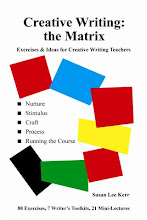Some Ways to Open a Story
- Dialogue
- Setting -- geography or weather
- Setting -- interior
- Monologue, first person
- Character description, third person
- Characters in action
Prepare the above list as a handout. Give students a stimulus (ideas below) or get them to have a story in mind, then give them the handout -- which is also a taskslip. Go round and tick one opening on each person's list -- a different one for each student. (Repeat the cycle for however many students you have.)
Instructions: With your story in mind, write an opening in the mode I've ticked, about half a page long. Remember to bubble first (my word for jot or list ideas) to help you expand and gather your thoughts.
After reading out and discussing the effects of the different openings you can extend the exercise by doing a new round of ticks. Like an absolute monarch you are imperatively forcing students to stretch themselves into devising a different manner of opening with the same story in mind. Or you can generously let them choose their own option from the list. When they moan, say: Yes, you must stick with the same story, the better to explore the effect! Further reading out and discussion follow of course.
Imperative Opening is in Section 3 VI, Craft: Storytelling Devices. It's Exercise 70 in Creative Writing: the Matrix paperback. It's Exercise 65 in Creative Writing: the Quick Matrix ebook.
Story stimulus exercises Above I promised you some starters if your students haven't yet got a few stories in mind. There are loads in the Craft section of the Matrix books -- Character's Journey, Opening with an Ending, Rainbow Tale, Agony Letter, Character Profile. See Exercises in the Labels list of this blog. There's always the trusty Postcard method: give each student an interesting picture postcard for story stimulus.
'It was a dark and stormy night...'? Maybe not. I wish you a bright and sunny season of teaching creative writing.


